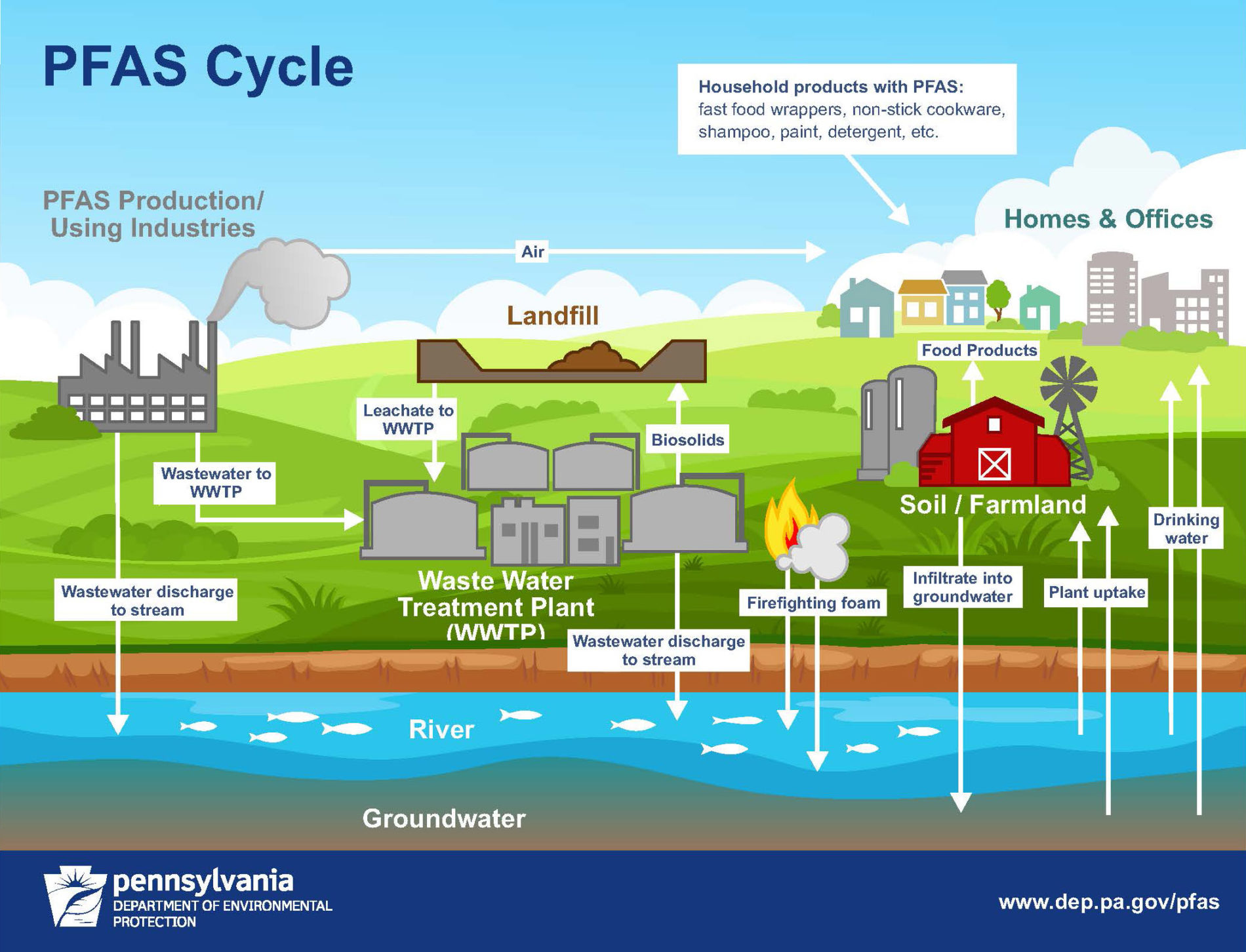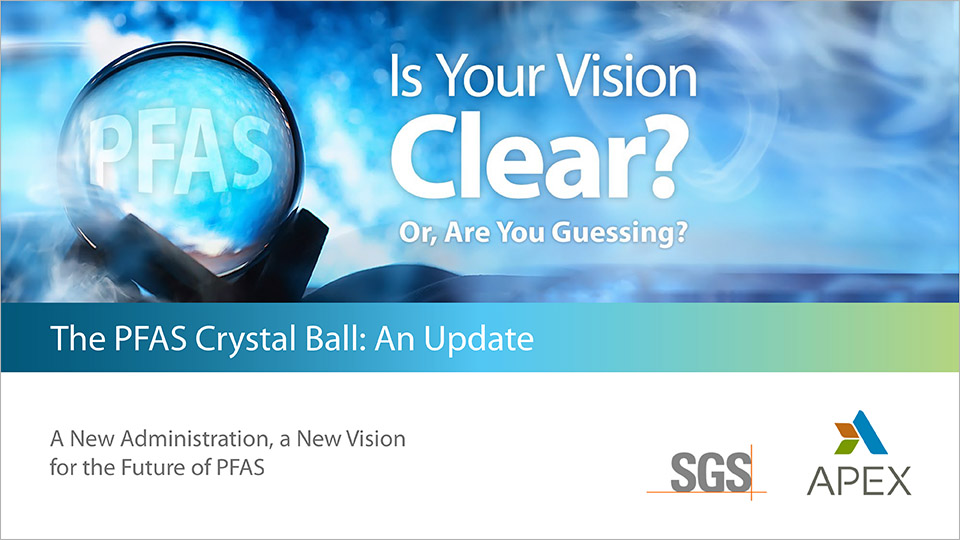PFAS Proposed Regulation and What it Means For You
Apex hosted a webinar with SGS on Wednesday June 9th 2021, during which we shared some predictions regarding the future of PFAS.
Like clockwork, on the following day EPA announced three new actions to reduce the potential risks to the public from PFAS. The actions include issuing a proposed rule to gather data on more than 1,000 PFAS manufactured in the US, withdrawing a guidance that weakened the EPA’s July 2020 Significant New Use Rule (SNUR) restricting certain long-chain PFAS, and publishing a final rule to officially include three additional PFAS into the Toxics Release Inventory (TRI).

PFAS Manufacturing
The EPA’s proposed rule will collect data from manufacturers of PFAS. It would require all manufacturers and importers of PFAS since 2011 to report information to EPA, including the chemical identity, categories of use, volumes manufactured and processed, byproducts, environmental and health effects, worker exposure, and disposal. This rule would provide EPA with additional data to support future regulatory and research efforts. The proposed deadline for reporting the PFAS data to the EPA is one year following the effective date of the final rule. A public comment period is currently open for 60 days.
What does this mean for you?
If your company manufactures products containing PFAS, or did after 2011, the new rule will mean that you need to track down significant information—think bills of lading, waste manifests, industrial hygiene monitoring reports, and manufacturing records. Even if the final rule does not include an exhaustive list or if it does not require detailed or year by year information, this is likely to come at a cost to many manufacturers. Not to mention that if puts a target on a lot of backs for future investigation and remediation activities.
PFAS SNUR
In accordance with Biden’s Executive Orders and other directives, the EPA has withdrawn a compliance guide that weakened the July 2020 SNUR. This SNUR prohibits companies from importing certain long-chain PFAS as part of a surface coating on items without EPA review and approval. The compliance guide was issued in January 2021 in the last days of the Trump Administration and limited what could be considered a surface coating. EPA has indicated they believe that this guide was issued by political officials and was not deemed necessary by career staff. In addition, the guide was finalized without considering or addressing public comments. EPA’s July 2020 SNUR continues to be in effect.
What does this mean for you?
For most, not much. The compliance guide only provided flexibility on a limited list of products that could contain PFAS in their surface coatings, including automotive parts, carpet, furniture and electric components. If your company imports products that contain certain long-chain PFAS as a surface coating, then you likely need to review the SNUR in greater detail to determine if it applies to you.

PFAS Reporting to TRI
For TRI Reporting Year 2021 (due July 1, 2022), three additional PFAS have been added to the TRI list because they are now subject to a SNUR under the Toxic Substances Control Act (TSCA).
The three PFAS added to the list include:
- Perfluorooctyl iodide (CAS No. 507-63-1)
- Potassium perfluorooctanoate (CAS No. 2395-00-8)
- Silver(I) perfluorooctanoate (CAS No. 335-93-3).
What does this mean for you?
Prior to 2020, the TRI did not include any PFAS. In December 2019, EPA added 172 PFAS for the 2020 reporting year, and the three just added bring the list up to 175 PFAS for the 2021 reporting year. Since TRI reports are due annually on July 1st, if your industry is in a covered sector and exceeds certain workforce and chemical thresholds, you will need to include any of the 172 PFAS added in 2020 to this year’s annual report. These additional three PFAS won’t need to be included in your TRI report to EPA until 2022. To determine if your industry is covered you can review the list of NAICS codes in 40 CFR 372.23. A full list of all TRI Toxic Chemicals and the year they were added is also available on the EPA’s website.
To learn more about our referenced webinar please feel free to reach out to us directly, or download our slides.
Apex Associated Press (Apex AP) represents contributions from various authors within the Apex professional community.
Disclaimer
Please note that all content provided on this blog is for informational purposes only and does not necessarily represent the views, opinions, strategy, or methods of Apex Companies, LLC (Apex). Apex makes no representations as to the accuracy or completeness of any information on this site or found by following any link on this site. Apex will not be liable for any errors or omissions in this information nor for the availability of this information. Apex will not be liable for any losses, injuries, or damages from the display or use of this information. Apex reserves the right to edit or delete any comments submitted to this blog without notice to whoever wrote, submitted or posted the comment. Anyone who submits or posts any material to this blog waives any right or claim to privacy with respect to the content submitted or posted. By submitting or posting any content, the person or entity that does so is representing that they believe it to be accurate, have a legal right to the content, and have legal authority to submit or post it. Please do not submit or post anything if this is not the case. Please consider these requirements carefully when submitting or posting comments, photographs or other material relating to third parties who may have privacy, ownership or other rights implicated by the content. Readers are encouraged to seek professional legal, scientific, and/or engineering consultation concerning specific environmental, engineering, or other concerns. If you would like to contact Apex for more information regarding professional consultation to address your specific concerns, click here.

